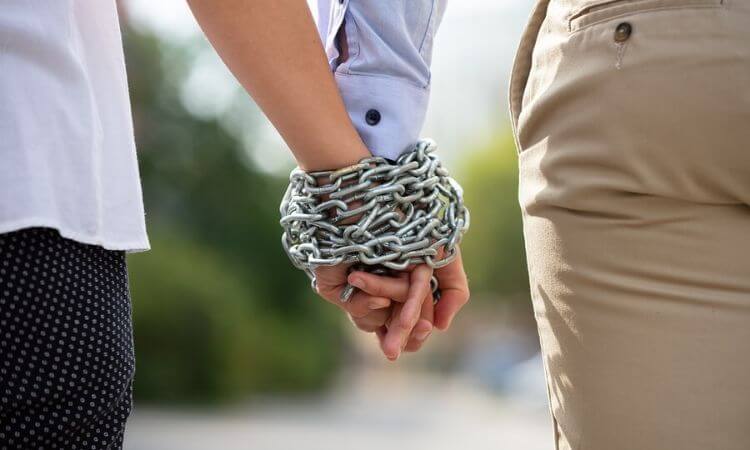
Codependency is characterized by a close relationship in which one individual has profound emotional needs, and a partner is forced to contribute an excessive amount of time responding to those needs. This frequently occurs to the detriment to one or both partners and even other significant relationships.
Codependency can lead to a downward spiral in which one partner actively tends to and even enables the emotional difficulties of the other. This cycle of behavior permits the loved one to continue acting in unhealthy ways.
What Is Codependency?
A codependent relationship consists of two members: the manipulator and the enabler. The enabler is usually a somewhat passive person who enables the manipulator’s toxic behavior. They may do so either consciously or unknowingly. The enabler often engages in submissive behavior in which he or she is forced to surrender a great deal of personal identity.
In the process, this person will neglect their own needs—or the needs of others—to satisfy the manipulator’s demands. These individuals often feel overly responsible for the feelings and well-being of others.
Codependency perpetuates a cycle of unhealthy behavior that doesn’t really help anyone, and can eventually ruin relationships and lives.
Signs of a codependent person include the following:
- Poor self-esteem or self-worth
- People-pleasing behavior
- Excessive caretaking of others
- Obsession with being in a relationship
- An absence of boundaries (e.g., offering unsolicited advice)
Signs of an emotional manipulator include the following:
- Deceptiveness, and being prone to skew other’s perceptions and reality
- Engaging in behaviors that aren’t in line with their words
- Frequently trying to make the other partner feel shame or guilt, especially when there is no reason for them to feel this way
- Acting as if he or she is the victim and is never at fault
- Frequently doing or saying things to instigate emotional reactions from the partner
- Eagerly volunteering or agreeing to help in a certain activity, only to complain that it’s a huge burden on him or her and that the partner should feel indebted
- Having a tendency to “one-up” other people by claiming that things are worse for them than others
An interesting but unfortunately feature of the manipulator is that they tend to dive into relationships almost haphazardly. When they identify a person they feel they can manipulate emotionally, they will jump in and try to secure their footing in the relationship as soon as possible. They often share too much too soon and expect the enabler to as well. Although they may exhibit vulnerability and sensitivity, this is really a ploy to make the other person feel special, empathetic, and ultimately bound to their feelings.
In general, manipulators are an emotional black hole—whatever they are feeling, they aim to suck others around them into those emotions for as long as possible. If he or she is in a bad mood, everyone around them will know it. And they are skillful at making others feel responsible for their moods and obligated to fix them.

Codependency and Drug Addiction
If just one member of a codependent relationship is abusing drugs or alcohol, it is usually the manipulator. This person frequently manipulates the partner into helping them get what they want. These wants may include money, shelter, alcohol, drugs, or any number of other resources. Manipulators know they have an advantage over the partner, and they use it to their benefit.
Codependency can occur without the presence of substance abuse, but the two are often correlated. In fact, codependent relationships were first identified among family members of alcoholics. Due in part to the toxic nature of addiction, codependent behavior is very common among those who have intimate relationships with another person who is struggling.
Codependency and addiction can manifest in a few different ways:
- Among partners who both abuse substances
- Among close adult family members and friends of a person abusing substances
- Among the minor children of people who are abusing substances
Sometimes the codependent person in the relationship is not a spouse or significant other. Instead, they may be the child of a person who abuses drugs and alcohol. This situation is more likely to occur when an addiction has progressed to the point that the child is required to take care of the parent’s needs frequently.
Adverse Effects and Risks for the Codependent Enabler
If the manipulating partner is abusing drugs or alcohol, both partners may experience many negative effects and risks based on the circumstances.
Some of these risks include the following:
- Increased risk of also developing an addiction, either to substances or behaviors
- Deep-felt loss of relationships and being social with others outside of the codependent relationship
- Inability to tend to obligations outside of the codependent relationship
- Neglect of personal needs, which can lead to poor health, depression, and worsening self-esteem
Adverse Effects and Risks for the Codependent or Manipulator

As for the individual struggling with substance abuse, the codependent relationship can also undermine his or her potential for recovery. In this case, the codependent relationship is an enabling force in the substance abuser’s life and may discourage them from making positive changes.
In fact, the enabling person may genuinely want to help his or her partner, but may also worry that the other person won’t need them any longer after the addiction is under control. This possibility may impede attempts to get help and allow the manipulator to continue suffering from addiction and face the related physical and mental health risks it produces.
This factor can lead to another significant risk if the person with an addiction does decide to get treatment. The enabling partner may feel at least somewhat dependent on their partner’s problems to maintain the relationship, so a return to this relationship after treatment could increase the risk of relapse for the addicted person.
Many contend that codependency may be regarded as a behavioral addiction itself. And because certain behaviors or compulsions are entangled with substance abuse, this can make it more challenging to address all the problems that an individual is facing.
Getting Treatment for Codependency and Addiction
Understanding and overcoming codependent behavior should be a vital part of an individual’s treatment when he or she enters a program. If issues in a codependent relationship go unresolved, the likelihood that an individual will be able to sustain long-term sobriety is diminished. This is true regardless of whether it’s the enabler, the manipulator, or both who are engaging in substance abuse.
Fortunately, there are several components of evidence-based treatment programs that can assist and support both partners in the codependent relationship and help them learn to interact in a healthier, more constructive manner. The enabling partner is usually encouraged to undergo long-term behavioral therapy to improve his or her self-confidence and ability to communicate personal needs and establish boundaries.
For those seeking help for addiction, a comprehensive treatment program, such as those provided by Midwood Addiction Treatment, offer customized plans designed to address the challenges associated with codependency. Using evidence-based methods, from behavioral therapy and family counseling to adventure therapy, we help individuals learn to overcome barriers that result from codependency and improve the likelihood of sustaining long-lasting recovery.
You can reclaim your life and experience the happiness and well-being you deserve! Call us today and discover how we can help you begin your recovery journey!